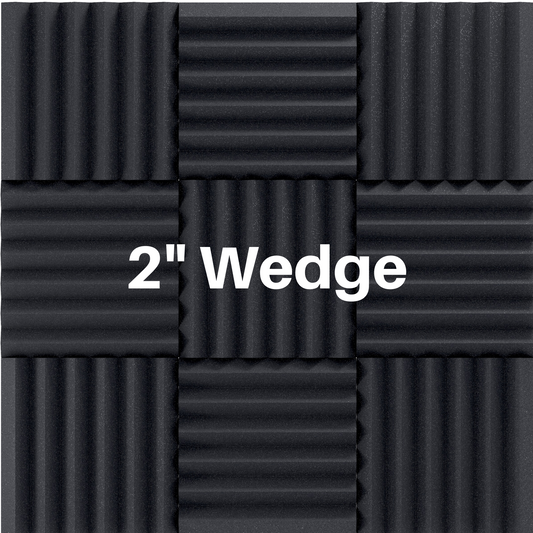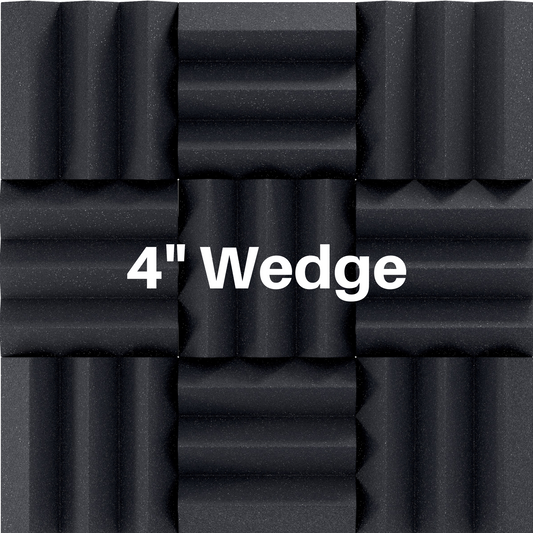Reverberation Time Calculator And Definition
Share
Reverberation Time Definition
Reverberation Time is the time it takes for a sound to decay by 60 dB and is sometimes abbreviated T60 or RT60. A T60 of less than 0.5 seconds is ideal for good speech clarity.
Reverberation Time Formula
To find the reverberation time (T60) of a room we use the equation:
T60 = 0.16V/A
- T60 represents the Reverberation Time
- V represents the total Volume of the room
- A represents the total Absorption of the room
The way we calculate reverberation time here is by using the total absorption of a room. This does not require any testing, microphones or speakers. You can find this by simply measuring the size of each surface in the room and finding the absorption coefficient of each material.
We will go over a specific example below if you want to see how to calculate long form. However, many people prefer to use a reverberation time calculator.
Reverberation Time Calculator
UPDATE: Check out our new and easy to use reverb calculator web app!
Our other free reverberation time calculator is in the form of an excel spreadsheet. You can open this with Microsoft excel or in Google sheets.
Here is a video explaining how to use the excel sheet calculator!
Another option is reverberation time apps!
A reverberation time app will often use your phone mic to record noise inside your room. The app will instruct you to clap, but we find popping a ballon works better. The app will analyze your sound data and provide estimated reverberation time.
Here are some of the best reverberation time apps:
IOS - ClapIR is a tool for measuring the acoustic properties of a room. Simply start the app and clap your hands. ClapIR then analyzes the clap's recording to calculate the room's reverberation times and frequency response. It's acoustics engineering made easy!
Android - Reverberation Time Pro - Before and during the measurement, it must be quiet in the room. The measurement is triggered by a loud clap or popping of a paper bag (use a balloon!). The determined value of the reverberation time is displayed immediately. For evaluating the average of 3-5 measurements should be used.
Reverberation Time Standards
The reverberation time for different rooms depends on what the room will be used for.
Our reverberation time chart shows the best reverberation time for common rooms including recording studios, auditoriums, lecture halls and more.

Reverb Time Calculation Example
Tip: to convert feet to meters take your measurement (in feet) and divide it by 3.28.
Example Room:
4 m wide x 5 m long x 2.5 m high
Building Materials:
Floor: carpet - thick no pad (NRC = 0.30)
Ceiling: gypsum wallboard (NRC = 0.05)
Wall 1: gypsum wallboard (NRC = 0.05)
Wall 2: gypsum wallboard (NRC = 0.05)
Wall 3: gypsum wallboard (NRC = 0.05)
Wall 4: gypsum wallboard (NRC = 0.05)
Floor: 4 m x 5 m = 20 m2 x 0.30 NRC = 6
Ceiling: 4 m x 5 m = 20 m2 x 0.05 NRC = 1
Wall 1: 4 m x 2.5 m = 10 m2 x 0.05 NRC = 0.5
Wall 2: 4 m x 2.5 m = 10 m2 x 0.05 NRC = 0.5
Wall 3: 5 m x 2.5 m = 12.5 m2 x 0.05 NRC = 0.625
Wall 4: 5 m x 2.5 m = 12.5 m2 x 0.05 NRC = 0.625
Total absorption in the room is 6 + 1 + 0.5 + 0.5 + 0.625 + 0.625 = 9.25
To find the reverberation time (T60) of the example room we use the equation:
T60 = 0.16V/A
A = total absorption = 9.25
V = Volume = 4 m x 5 m x 2.5 m = 50 m3
T60 = 0.16(50) / 9.25
T60 = 0.86 seconds
This example room would need treated with some sound absorbing materials to bring the T60 down below 0.5 seconds for good speech clarity.
Below is a table for reference showing the absorption coefficients for common building materials.
|
Absorption Coefficient |
|||||||
|
Material |
125 Hz |
250 Hz |
500 Hz |
1000 Hz |
2000 Hz |
4000 Hz |
NRC |
|
Gypsum wallboard |
0.29 |
0.10 |
0.05 |
0.04 |
0.07 |
0.09 |
0.05 |
|
Concrete block |
0.10 |
0.05 |
0.06 |
0.07 |
0.09 |
0.08 |
0.05 |
|
Plywood |
0.28 |
0.22 |
0.17 |
0.09 |
0.10 |
0.11 |
0.15 |
|
Carpet - thick no pad |
0.02 |
0.06 |
0.14 |
0.37 |
0.60 |
0.65 |
0.30 |
|
Carpet - thick with pad |
0.08 |
0.24 |
0.57 |
0.69 |
0.71 |
0.73 |
0.55 |
|
Brick - galvinized |
0.03 |
0.03 |
0.03 |
0.04 |
0.05 |
0.07 |
0.05 |
|
Light velour fabric |
0.03 |
0.04 |
0.11 |
0.17 |
0.24 |
0.35 |
0.15 |
|
Medium velour fabric |
0.07 |
0.31 |
0.49 |
0.75 |
0.70 |
0.60 |
0.55 |
|
Heavy velour fabric |
0.14 |
0.35 |
0.55 |
0.72 |
0.70 |
0.65 |
0.60 |
|
Concrete or terrazzo flooring |
0.01 |
0.01 |
0.02 |
0.02 |
0.02 |
0.02 |
0.02 |
|
Linoleum |
0.02 |
0.03 |
0.03 |
0.03 |
0.03 |
0.02 |
0.05 |
|
Asphalt |
0.02 |
0.03 |
0.03 |
0.03 |
0.03 |
0.02 |
0.05 |
|
Tile on concrete |
0.02 |
0.03 |
0.03 |
0.03 |
0.03 |
0.02 |
0.05 |
|
Glass - large heavy panes |
0.18 |
0.05 |
0.04 |
0.03 |
0.03 |
0.02 |
0.05 |
|
Marble |
0.01 |
0.01 |
0.01 |
0.01 |
0.02 |
0.02 |
0.01 |
|
Water surface - pool |
0.01 |
0.01 |
0.01 |
0.02 |
0.02 |
0.03 |
0.01 |
If you still have questions we are glad to help you! Please contact us anytime or fill out our free acoustic room analysis!
If you require a more thorough examination and strategic planning, we suggest considering our premium acoustic consultations. Our consultations offer a comprehensive analysis and strategy development for your acoustic needs. Check out our premium acoustic consultations!
Read More:
What Is Transmission Loss Of Sound ?
What Is Noise Reduction Coefficient (NRC) ?
Soundproofing Foam For Music Studios





2 comments
Do you have your download sheet in your reverberation time computation in excel??
Thank you for sharing this insightful post. I found it to be engaging and informative, and I appreciated the unique perspective that you offered. Keep up the excellent work.